Extraversion / Introversion & the hand:
6 Hand signs!
Despite that most people can best be described as 'ambiverts', the dimension Extraversion-Introversion is generally considered as a key-dimension of human personality.
The terms 'extraversion' and 'introversion' were first popularized by Carl Jung (1913) and became later included in many personality theories; today some speak even about the so-called 'extravert ideal' (a term recently introduced in 2012 by American author Susan Cain).
This article presents a first (solid) attempt to describe how the dimension Extraversion / Introversion can be recognized via a (multi-perspective) study of the hand.
The results are based on a hand study in 48 Dutch people: 27 extraverts + 21 introverts (including: 34 females & 14 males) - who were selected by age (19-54), ethnicity (white), IQ (above average) and high/low scores on the Extraversion dimension of the Dutch version of the NEO PI-R personality questionnaire.
All hand materials were collected in 1997/1998.
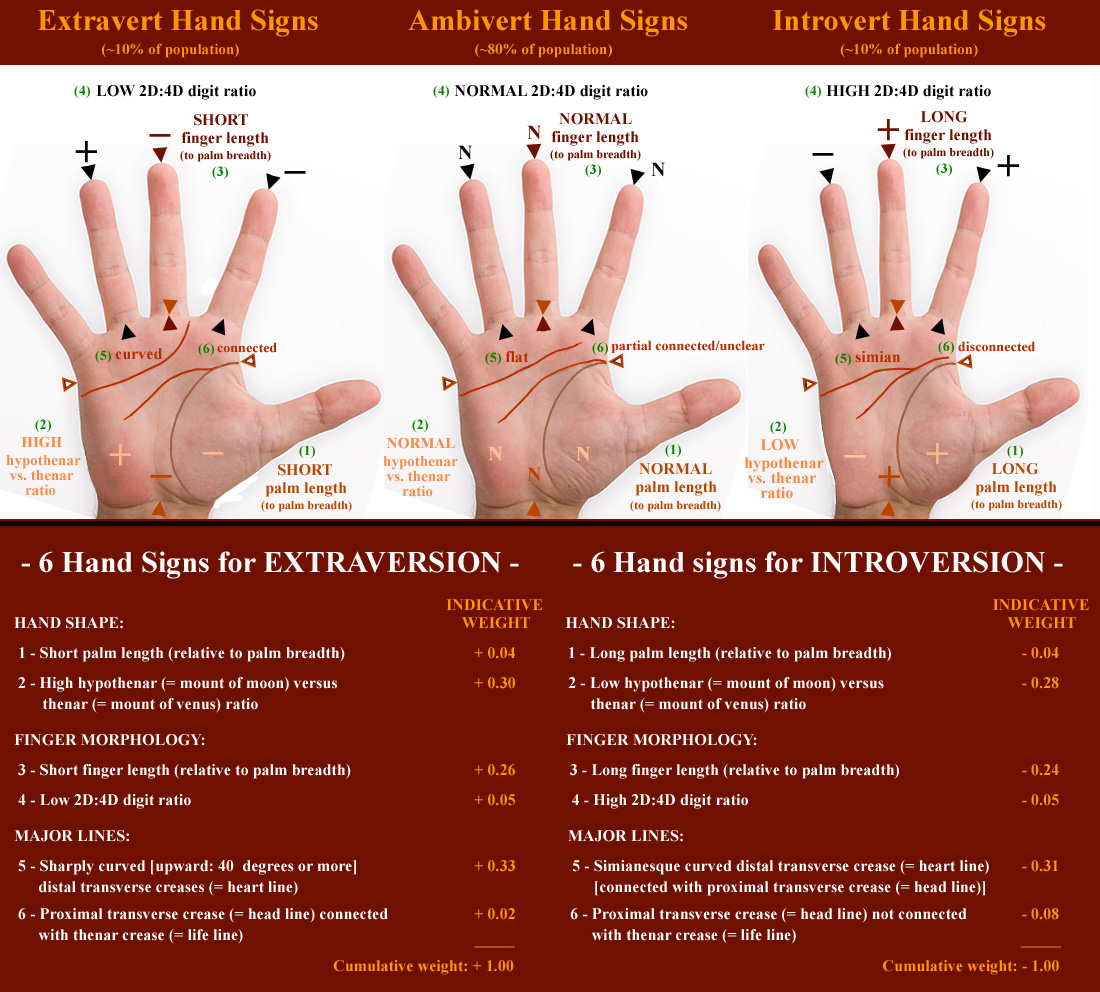 6 Hand signs have been identified featured with strong, consistent results for both the male- and female group.
6 Hand signs have been identified featured with strong, consistent results for both the male- and female group.
A schematic visual summary is presented at the BOTTOM of this page.
CONTENT OVERVIEW:
• Extraversion & the Big Five model
• Extraversion defined by detail: 6 facets [according NEO PI-R]
• Extraversion fluctuates around the world
• Extraversion in the hand reading literature!
• RESEARCH RESULTS: 6 Hand signs for Extraversion & Introversion!
Extraversion & the Big Five model
Over time Various independent researchers concluded that human personality can best be descrived using five broad factors.
This explains why in time the Big Five framework presented by Costa & McCrae (1992) became recognized as representing the standard in academic psychology.
The Big Five factors are:
Extraversion - Neuroticism - Openness - Agreeableness - Conscientiousness
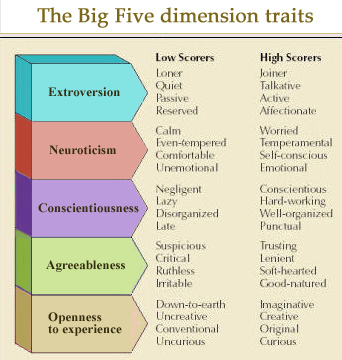
Wondering about your Big Five personality profile? There are various credible online Big Five online tests available; the picture below presents 2 Big Five profiles resulting from the
BBC Big Five test
(NOTICE: 'low' scores for Extroversion can be associated with Introversion; 'medium' scores with Ambiversion; and 'high' scores with Extraversion).
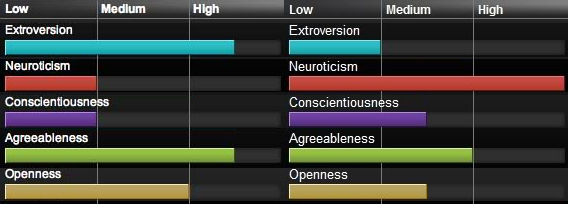
Extraversion defined by detail: 6 facets [according NEO PI-R]
Though the verb 'extraversion' has become an element in the daily lives of many people, but sometimes it appears as if individual tend to atribute different meaning to the word.
This is probably because the word kind of has various meanings in different contexts.
The terms introversion and extraversion were first popularized by Carl Jung (after Freud had adopted the word in his 'libido' psychology),
although both the popular understanding and psychological usage differ from his original intent.
The trait of extraversion-introversion is now known as a central dimension of human personality theories:
Extraversion tends to be manifested in outgoing, talkative, energetic behavior, whereas introversion is manifested in more reserved, quiet, shy behavior.
Virtually all comprehensive models of personality have adopted these concepts in various forms - examples are: the Big Five model, Jung's analytical psychology, Hans Eysenck's three-factor model, Raymond Cattell's 16 personality factors, the Minnesota Multiphasic Personality Inventory, and the Myers Briggs Type Indicator.
The picture below presents an overview of six facets of Extraversion according the Big Five model (the NEO PI-R questionnaire is measuring each facet through 8 multiple-choice questions).
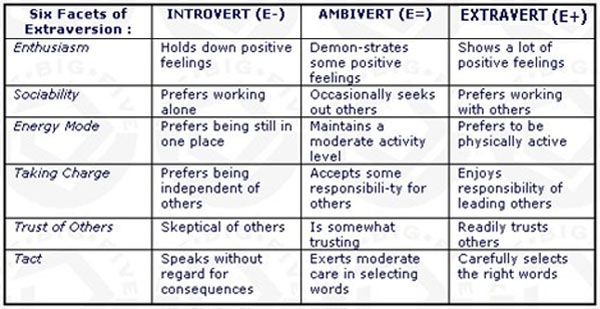
NOTICE: "Although many people view being introverted or extroverted as a question with only two possible answers, most contemporary trait theories measure levels of extraversion-introversion as part of a single, continuous dimension of personality, with some scores near one end, and others near the half-way mark.[10] Ambiversion is a term used to describe people who fall more or less directly in the middle and exhibit tendencies of both groups. An ambivert is normally comfortable with groups and enjoys social interaction, but also relishes time alone and away from the crowd." (cited from Wikipedia)
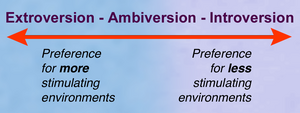
In 2012 Susan Cain's argues in her bestseller
Quiet: The Power of Introverts in a World That Can't Stop Talking
how modern Western culture misunderstands and undervalues the traits and capabilities of introverted people, leading to
"a colossal waste of talent, energy, and happiness."
Cain defines the introvert-extrovert spectrum in terms of preferences for different levels of stimulation.
Her definition for Introversion is: "introverts have a preference for a quiet, more minimally stimulating environment" (see also picture above).
Extraversion fluctuates around the world
 Studies around the world have indicated that the distribution of mean Extraversion factor scores fluctuates around the world - see pictures
(McCrae
Studies around the world have indicated that the distribution of mean Extraversion factor scores fluctuates around the world - see pictures
(McCrae, 2004;
23andMe, 2011;
MyPersonality, 2008).
The data reveals that people from Europe & US tend to score higher for Extraversion than people from Asia (
Allik & McCrae, 2004).
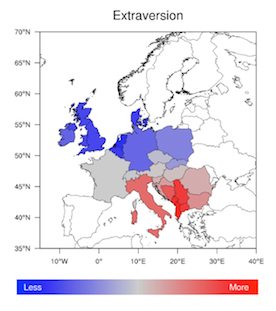

Extraversion in the hand reading literature!
What does the hand reading literature report about extraversion/introversion?
Various authors have presented attempts to define 'extraversion' and/or 'introversion' through a combination of hand characteristics:

Arnold Holtzman:
- 'Applied Hand Reading':
• page 41 - EXTRAVERT: hard hands; INTROVERT: soft hands;
• page 68/69 - EXTRAVERSION: flattened lower part of hypothenar (mount of moon);
• page 69 - INTROVERSION: swelled lower hypothenar (mount of moon) and dropping into the wrist.
- 'Psychodiagnostic Chirology in Analysis and Therapy':
• page 41 - EXTRAVERT: an extrovert formula would be the rule when the life instinct (area just below the point of origin of the upper transverse crease) is the driving influence; INTROVERT: an introvert formula would be the rule when the death instinct (= pronounced plunge of the hypothenar eminence into the wrist) holds sway over an individual's program of survival;
• page 68 - EXTRAVERT: hard hand; INTROVERT: soft hand.

Johnny Fincham:
- 'The Spellbinding Power of Palmistry':
• page 37 - EXTRAVERT: thumb angle: 90 degrees; INTROVERT: thumb angle: 20 degrees or less;
• page 42 - INTROVERT: all fingers leaning to little finger side;
• page 113 - INTROVERT: fragmented girdle of venus;
• page 117 - INTROVERT: very strong sun/apollo line.
- 'Palmistry: From Apprentice to Pro in Twenty-Four Hourse':
• page 197 - INTROVERT: closed fingers tightly together; skin quality: either silk or course; lines: faint and fine or thick and trench-like; head line: curves deeply (downward);
• page 198 - INTROVERT: head line: tied to vitality line; long 2nd finger; EXTRAVERT: 'naturally hold their fingers wide spread'; 4th finger: long; head line: straight; lines: strong and bold; large gap between head line and life line.
(NOTICE: It's rather remarkable that in the perspective of Extraversion/Introversion Fincham appears to talk about completely different hand features in each of his books...???)

Nathaniel Altman:
- 'Sexual Palmistry':
• page 20 - EXTRAVERT: spatulate hands;
• page 67 - INTROVERSION: small, deficient lower mount of mars;
• page 80 - EXTRAVERSION: head line seperate from life line;
• page 132 - EXTRAVERSION: angle between index finger and thumb;
• page 137 - EXTRAVERSION: flexible hands, generous thumb.
HAND RESEARCH RESULTS:
6 Hand signs for Extraversion & Introversion!
This concerns a study of hand signs in the perspective of the Big Five dimension Extraversion in a Dutch population of 48 subjects
(14 female + 7 male introverts scoring 8 or 9 on the Dutch NEO PI-R personality questionnaire; and 20 female + 7 male extraverts scoring 1 or 2).
 A 'multi-perspective' exploration of the hands (hand prints) has resulted in the identification of 6 hand signs with strong (consistent) results for both the male- and female groups.
A description for the 6 individual hand signs in the 'Hand Model for Extraversion' is presented in table 1.
A 'multi-perspective' exploration of the hands (hand prints) has resulted in the identification of 6 hand signs with strong (consistent) results for both the male- and female groups.
A description for the 6 individual hand signs in the 'Hand Model for Extraversion' is presented in table 1.
TABLE 1: Pearson correlations for 6 hand signs.
|
HAND SIGNS
|
DESCRIPTION
|
|
1 - PL:PB ratio
|
Palm length (pl) : palm breadth (pb) ratio
both dimensions measured with ruler
|
|
2 - HypoTh:Th ratio
|
Hypothenar (HypTh) : thenar (T) ratio
both zones assessed for overall development
|
|
3 - FL:PB ratio
|
Finger length (fl) : palm breadth (pb) ratio
both dimensions measured with ruler
|
|
4 - 2D:4D digit ratio
|
2D:4D digit ratio
both finger lengths measured with ruler
|
|
5 - Distal crease term.
|
Distal crease radial termination
upward curved / flatly curved / simian crease
|
|
6 - Prox. crease term.
|
Proximal crease radial termination
connected / partial connected / disconnected
|
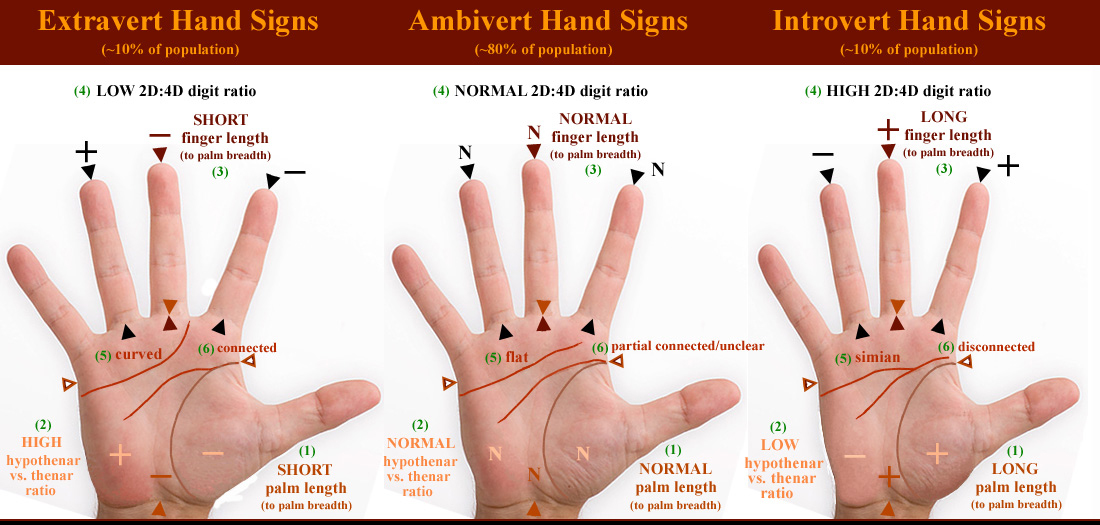
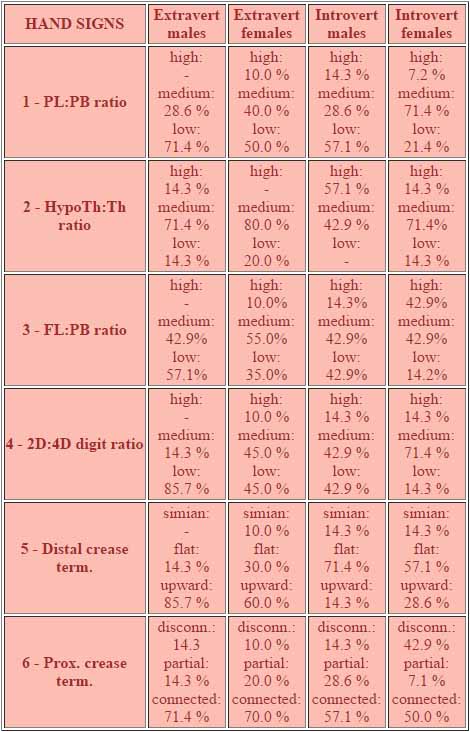
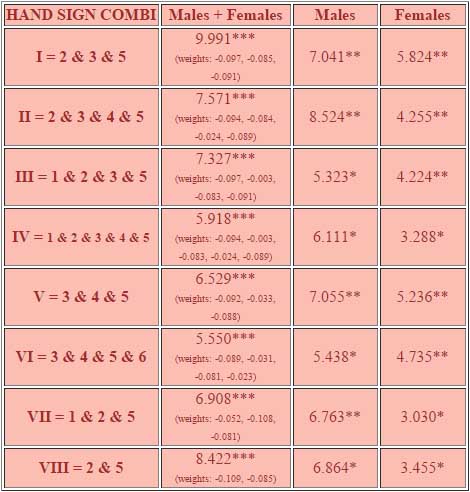 * p = sign. at 0.05; ** p = sign. at 0.01; *** p = sign. at 0.001
* p = sign. at 0.05; ** p = sign. at 0.01; *** p = sign. at 0.001
